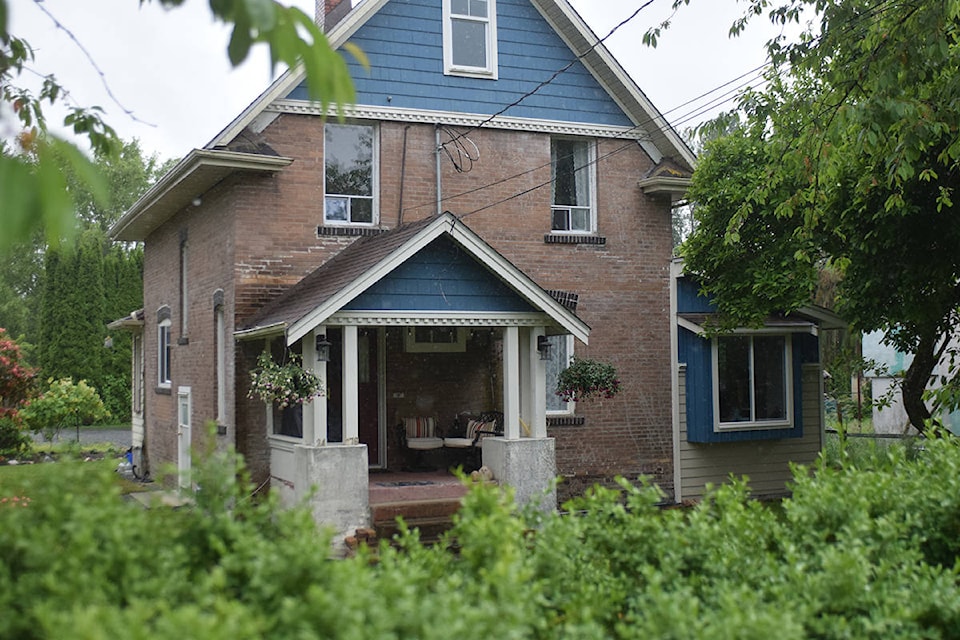A historic property in the middle of Clayburn Village is raising questions about the town’s past, its future, and what – exactly – makes a heritage home a heritage home.
Two years ago, Sebastian Naslund bought a 100-year-old home on Clayburn Road, just two doors down from Clayburn Village Store.
Naslund then applied to subdivide the large lot on which the house sits, and build another home – and a coach house behind it – next door. He said he would keep the original home, and pointed out that the house sits on what was once two lots, and which were only joined in 1975. Splitting them apart again, he argued, would be in keeping with the village’s past.
He said the house was formerly occupied by the developer of dozens of homes in the area, and that the new house would be built with heritage elements to complement the neighbourhood.
The definition of heritage is “always changing,” said Naslund, who said he had previously volunteered in the Clayburn Village Museum. “We can either have negative change over time or positive change.”
But the Clayburn Village Community Society (CVCS) argues that the large lot holds significant historic value that will be lost if it is subdivided.
Cathy Carder, the spokesperson for a CVCS committee formed in response to the proposal, said the home was originally built in 1911 for Roderick Reid, the Clayburn Brickworks works accountant and the third-highest-ranking company employee.
Clayburn Village, she said, was a company-built town, and the scale of the house and its lot deliberately reflected Reid’s position in the company.
“It’s been preserved since it was built to show the prestige of Mr. Reid,” she said. “The history isn’t just the historic house on the property; it’s also the size of the lot.”
Although the property originally sat on a pair of lots, Carder said those lots were created before the Brickworks realized they needed to build a home for Reid. Once they built the house, she said the second lot went deliberately unused.
Carder said building a new two-storey home next door will also detract from the scale of Reid’s modestly sized house. And she’s worried it will open the door to more subdivisions and infill in the area that would change the feel of the small community.
“Clayburn is a village,” she said. “It has to remain a village.”
• • • • •
The proposal was first seen by council more than six months ago, and they unanimously voted to send it to a public hearing. That usually happens within weeks, but it has not yet taken place.
A city spokesperson wrote in an email that there were “some procedural issues that needed to be worked through.”
Carder said the delay is partly because a CVCS director wrote a letter of protest to the city, objecting to what they said was a lack of consultation with the group.
“Our biggest frustration is that the CVCS has not been included at all,” she said.
The house sits in the Clayburn Village Heritage Conservation Area, which aims to “recognize and enhance the historic nature of Clayburn Village for the benefit of present and future generations,” and any change to the house or its lot requires a heritage alteration permit.
A sign notifying the public of the application was posted last July, several months before the plan went to council.
The CVCS, which also operates the Clayburn Village Museum, said it was not asked to provide any input prior to the November meeting, when a staff report presented to council provided support for splitting the lot and providing a heritage alteration permit, which is necessary for such heritage properties.
That report said: “The proposed subdivision would reestablish the original two lots from the historical subdivision which aligns with the objective to respect the history of Clayburn Village.” It did not include historical details about Reid’s residency cited by Carder.
Carder said the group also wasn’t able to present that information to members of the city’s development advisory committee, which considered the issue at a meeting in May.
She said the city had consulted with the CVCS prior to past development proposals.
In reply to a query about why the CVCS was not directly consulted, a city spokesperson wrote that rules that regulate the development application process don’t require consultation with groups like the CVCS. in an email. The city’s development application procedures do, however, permit such consultation if it is deemed helpful.
“Every application will be referred to private utilities, agencies, organizations and senior government, for review and comment, as deemed appropriate by the director,” the bylaw says.
Carder also said the CVCS worries that the city’s new Official Community Plan – which guides staff in evaluating development proposals – opened the door for other small infill subdivisions.
Although the development of the OCP involved an extensive consultation process, Carder said the CVCS was not made aware of how the specific changes would affect Clayburn Village.
“We had no idea,” she said. “It hadn’t come to our attention.”
The city spokesperson wrote that, “The City did not specifically meet with the CVCS during the OCP consultation, although there were many opportunities for all groups, associations and organizations to provide input they felt was important into the process.”
It’s unclear when the proposal will come for public hearing.
This story originally reported that the CVCS owns the Clayburn store. That is incorrect and has been changed.
@ty_olsen
tolsen@abbynews.com
Like us on Facebook and follow us on Twitter.
